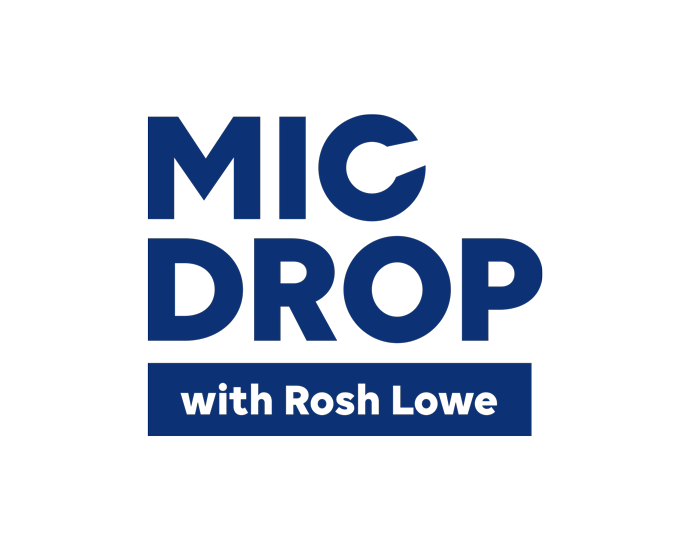The Birth of MicDrop
By Rosh Lowe
How did Eli Nash do it? How did he go from introvert to someone standing on the TedX stage? For people to understand the transformation, they have to first know how the MicDrop Method was created. It was six years ago when I first developed this method for Eli. The same method has now been used on hundreds of people. The MicDrop Method is about creating a connection with an audience. As you read this post, I encourage you to apply the lessons to your own story and you will be speaking in no time.
Eli was the main financial supporter of an organization that provided support for child sex abuse victims. Eli is a survivor himself. When the organization asked him to share his story at a fundraising event Eli was faced with a problem he had been dealing with since childhood, a debilitating fear of public speaking.
“I know what it feels like to be anxious,” I told him. “I want to help you.” There is one area of my life where I have no anxiety and that is public speaking.”
Eli’s speech was going to be in front of hundreds of people and he was petrified. It was the first time he would go public about his abuse. How was he going to do this? He could ignore the request, politely decline the invitation and remain silent. Or he could stand up there and be a light unto others. He chose the latter and hired me to help with his preparation.
Eli was first and foremost a businessman. So, before I began to work with Eli I knew I needed to be prepared also. Secondly, I knew that I had to accomplish this goal quickly. Eli did not have the patience for disorganization or theory. He wanted a practical approach to public speaking.
I asked for his trust, told him to throw out any preconceived notions of public speaking and we began. He had written a speech but instead of reading this speech and using a piece of paper as a crutch, we worked on bringing the speech alive.
I thought of all the directors I worked with over the years in the theater and the performers I shared the stage with. What did Angela Lansbury, Ben Vereen, Mandy Patinkin, and Esther Rolle all have in common? They controlled the stage. There was a passion and a depth of emotion that I simply did not see anywhere else.
“In order to connect with an audience, you need to open up,” I told Eli. “Once again you need to be comfortable. This does not mean you are sharing deep dark secrets. This simply means you are sharing with the audience a part of you that for whatever reason you have hidden. This could be your humorous side. This could be your emotional side. The first step in performance is vulnerability.”
You have to be confident to be vulnerable. You can’t begin to find self-assurance if you don’t reflect on what makes you stand out from the crowd.
“Examine your life and write down one thing that makes you unique. You have earned the right to speak! This is the first milestone in building confidence and a very difficult step. What makes you unique?” I asked him.
Silence.
People tend to get stumped when I ask this question. It always takes a few minutes until they begin to process their story.
“As you put your life under a microscope you will soon discover a hero emerges. That hero is the truest version of yourself. How do you expect an audience to pay attention if the speaker is insecure? Security is discovered when you realize what you have accomplished in your life,” I told Eli.
I needed to create a road map for Eli. Speakers get nervous because they get lost. The easiest way for a speaker to stay on track is to know where the speech is going.
The structure of a speech involves the following steps:
1.Message
2.Character Development
3.Drama
4.Realization
5.Closing message
The message of the speech is the reason you are there. What are you trying to convey to the audience? Boil your message down into one sentence. Hit your audience over the head, make them look at you and realize exactly where you are going with your speech. There should be no question why you are speaking. The message will immediately establish a relationship with the audience. A clear theme will engage those listening. And it needs to be simple. People connect with simplicity.
The character portion is the section where the audience gets to know you. An audience needs to care about who is delivering the speech. In TV news, we call this the “why do I care factor.”
This is revealing something personal about yourself that will create a trust bond. When you begin a speech, there is a separation between the speaker and those listening. The key is to slowly erode the divide. Why should they want to listen to you? You need to make audiences invested in the speech. People attach themselves to people more readily than ideas or concepts. You can start a speech with a concept but it must be followed with the human element. As a speaker, you need to sell the story by personalizing the message and embracing yourself as the star. On the day of the speech look at the faces of your audience. There have been times when I have made last-minute changes specifically because I could see that a line wouldn’t work. The key is to deconstruct the audience. Tear them down and then build them up.
The drama is the most important part of any speech. This is conflict. Audiences connect with struggle. This can be a personal struggle or it can be a societal struggle. But this is where you continue to reel in the audience. The audience becomes connected to the speaker in the character development section. They care about you. Now they will root for you as you conquer a battle. Audiences connect with the underdog and the concept of a quest.
Realization is the portion of a speech where lessons are learned. What have you taken away from the struggle? How have the obstacles changed you? Audiences always want to feel as if they have learned something from a speech. This is where you can educate your audience.
This leads you directly into the closing message. Most speakers run out of steam when they get to their closing. They see the finish line and just want the speech to end. They’ve made it. Now let’s get it done. The opposite is true. A closing message has to be as energetic as your opening. You need to leave the audience with something to think about. This can only happen when a speaker delivers a final blow. This is a knockout punch. You have several options. You can have a call to action where you ask the audience to do something. Or you can express a future vision. But you end strong. An audience remembers the first two minutes and the last two minutes.
This follows the classic story arc. There needs to be an introduction followed by rising action leading to a climax. We then have a turning point, falling action, a moment of suspense, leading us to our closing message. In a speech, you are painting the pictures, conveying the emotions, and using body language and vocal intonation to transition between scenes.
How would you tell your Aunt Sally your story?” I asked Eli. “Would you be reading your story from a piece of paper? Probably not. You would be animated. You would use vocal intonation and body language to convey your point.”
“Ok that’s fine,” said Eli.
“And I want you to do this with minimal notes,” I said.
This was a game-changer. Most people who come to me often rely on notes. This is the fastest way to bore and lose an audience.
“And how is this done?” he asked.
“This is where scene structure comes in,” I said, “We will break up your speech into a series of scenes. Each scene will have a title.”
“I am turning you into a performer,” I told Eli “And what I have realized is that most people want to be the star. I have taken people with zero theatrical experience and I have turned them into good performers. Performance does not mean you are disingenuous. It is simply a way to create a barrier between the fear and the function. My emotional state was put on display at a young age in front of thousands of people. Performers by nature are an open book. You need to open your soul to allow the audience to feel your character and journey. When you have trust in your story and the audience, you will feel a new level of confidence.”
“It seems fake,” he said, “like acting.”
I saw that Eli was uncomfortable. It made sense. This was a challenge. How was I going to turn Eli who had never been on the stage into a performer?
“I once asked a seasoned actor, “How do you know when you are performing well?” His response to me was something a child could digest (I was eight at the time). He said, “Rosh think of a violin and take the strings apart. Each string will contain an emotion. You have fear, joy, love, hope, and sadness. Now imagine connecting one part of that string around your waist and the other end you will stream to the audience. Let’s take joy, for example. Allow that joy to travel along the string to the audience. When your heart swells up with immense happiness you will feel the happiness in the audience.”
“You want me to act?” asked Eli.
“I want you to get into character and create a bond with the audience,” I responded. “The first step is understanding that the audience is not your foe. Once you can rethink the concept of the relationship with the audience you can ask yourself a fundamental question, what does the audience want from me? Timid communicators build up fantasies in their mind where the fear of judgement and ridicule become the driving force. This needs to be replaced by reframing the speaker- audience relationship. In many ways, the speaker is there to teach the audience. The speaker is the enlightened one who is going to give his/her target a new way to view life, a new recipe for battling obstacles, a new way to think. If you view the audience as a friend who is waiting to benefit from your knowledge the fear dissipates. So, before you start any conversation or give any speech, ask yourself what am I trying to say and what does my audience need from me? Once you have the audience’s attention you need to make them care. How do you accomplish this? Ask the audience a question? Make them think. After you get them to think hit them over the head with honesty. Audiences want to know that the person speaking to them is real. I often use, “I want to level with you, I am going to let you in on something I am going to tell you something now that I haven’t shared before. The audience needs to understand that they have a vested interest in the speech.”
I told Eli that emotion was his greatest connective device.
“Emotion does not mean tears!! It can be joy. It can be fear. It can be hope. When I was in college I took a course in Artificial Intelligence. In this class, the professor said, “you can’t teach a robot how to feel. Don’t become a robot. The feeling is what separates the human being from the robot. It is this depth of emotion and complexity of character that also united us. Show me and don’t tell me. This is a well-known saying in television news. If there is a house on fire don’t tell me how fierce the flames are, show me the flames. In a speech don’t tell me your thoughts show me your thoughts. I like to make this message very apparent. Come out swinging. You must know what moves the audience. How do you come up with the right words to connect? You have to know what moves your target. Every single person has that vulnerable place. Once you pry it open, the depths of connection become limitless. Vulnerability without structure is frightening! Vulnerability with structure is power. The key to following the formula is that it will allow you to open up without the risks. You have a road map. You have a guide. Once again, you need to be comfortable. This does not mean you are sharing deep dark secrets. This simply means you are sharing with the audience a part of you that for whatever reason you have hidden. Deliver the unexpected.”
So often when people construct a public talk they focus on the words, the sentences, the paragraphs. I explained to Eli that we throw all of this out the window.
“I focus on the scenes that correlate with the structure. Scene structure is a process where strong mental images bring the speaker and the audience into the scene. This allows the speaker to rely less on notes and more on detail. Within each scene, your character will convey the images, dialogue, and emotion necessary to propel your story into the next sequence. You will be able to visualize the speech. It will also help you understand story structure and where you are moving with the speech. The audience will be able to know when you are transitioning between scenes through body language and tone of voice. The mental imagery of scenes instead of memorizing words has enormous benefit. It separates good speakers from great speakers. A speech needs to be performed. It needs to be vivid, passionate and real.”
Now we needed to get to Eli’s story, the content of his speech, so I used my interviewing skills. This was easy for me. I had spent twenty years getting people to open up. This was how I scored all my exclusive interviews. The initial interview process is a tremendous way to reach a deeper level that removes subconscious obstacles and fears. Passion is crucial in public speaking. If you are passionate and you care about your speech, the audience will care as well. Once you can scratch the surface in the interview process your entire speech will take shape. You will find your message.
“Stop for a moment, let me ask you some questions,” I said.
“Take me back to where you grew up. What was it like?”
“It was insular. We all knew each other,” Eli said.
He grew up in a section of Brooklyn where there were numerous observant Jewish families on a block. Everyone stuck together. They dressed alike and they operated on a foundation of trust amongst each other.
“And tell me about your abuser, did your family know him?” I asked.
Eli began to well up with emotion, “Yes some of them even said why can’t you be more like him.”
Eli started to remember images, details, that he had blocked out. He began to feel his story. It was a different level of expression. He remembered the color of his bedsheets. He could feel the abuser get on top of him. He could feel the suffocation. When he could feel it- I could feel it.
This is what an audience wants to experience. When you are sitting at a nonprofit event you expect the speeches to be dry. But you want to be impacted. My theory is that the world of the theater is not just reserved for stages and concert halls. We live in the world of theater. We all want to be moved. The only way Eli got to this point was by feeling his own story. He became the character of the eight-year-old boy who was abused. I had him start his speech with a photograph of himself at eight years old.
“Take a look at this picture. What do you see?” he asked. The use of this picture screamed theme.
“I see innocence. I also see what was taken,” he continued.
Eli stood in front of me. His voice trembled.
“I can’t do this.”
“Yes, you can,” I said. I encouraged him to continue.
“Ok I got this,” he said taking it from the top.
“I grew up in a community where we all knew each other. We all trusted each other.”
Eli was able to make me care about who was delivering the message.
He then spoke about how the organization tracked down his abuser and helped him find closure. We found the deep-seated emotion beyond the simple storytelling. When it was time for his performance- he looked down at his notes and saw that one-word Confrontation.
Immediately, Eli was taken back to the confrontation itself.
“I always imagined this guy as much taller than me. When he agreed to meet with me twenty years later he looked so small.” Eli was able to fly through this section. There wasn’t the slightest quiver in his voice.
“How can you have nerves when you are no longer thinking about getting the words out? The words flow. The brain can only be occupied with one thought at a time,” I told Eli. No longer was he thinking about his nerves, he was now immersed in the story.
Eli went on to deliver this talk and many others. The Micdrop method was born.



